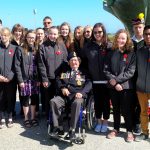Book Reviews by students of John Myers at OISE.
By Liberty Vorvis
Thea Halo’s Not Even My Name (2000, Picador) is a memoir detailing the exploitation experienced by a death march survivor, as seen through the eyes of a young girl (Halo’s mother) living a life of exile and loss in 1920s Turkey. It is a highly personal tale of struggle and triumph. Not Even My Name connects the past to the present day for readers, since Halo tells the tale as she travels to Turkey with her mother in the hopes of discovering the remnants of a people long since banished from their ancestral land.
The content of this book best applies to the Grade 11 Origins and Citizenship: The History of a Canadian Ethnic Group (CHE30) course. It can also be applied to the Grade 11 World History since 1900: Global and Regional Interactions (CHT30) course, or the Grade 12 World History since the Fifteenth Century (CHY4U/C) courses.
Not Even My Name is a useful curricular resource since it is an excellent way for students to gain a human connection to the tragedies faced by many exiled refugees living among us. It provides a well-written personal account that helps students connect to a person’s harsh reality. I would use excerpts of it as diary entries, and students could use them both to piece together an immigrant’s experience and to further connect with it. It can also provide context and a look at the experience of immigrants living in Canada or the United States in the 1950s. I would shape some of the units to include immigrant experience, and connect it to the plight of Syrian refugees today. Students can do a research project that examines the experience of refugees fleeing the Middle East today.
By Sophie Pigon
“A story of the triumph of the human spirit, a story of one woman’s profound faith and determination to survive (against literally impossible odds).”-Dr. Wayne W. Dyer
Immaculee Ilibagiza’s, Left to Tell: Discovering God Amidst the Rwandan Holocaust (2007, Hay House) represents a powerful and intelligent woman who, against all odds, survived the horrific atrocities that occurred during the Rwandan Genocide. Left to Tell does well in capturing the heartfelt emotion and recounts the tools we have in overcoming hardship. This book has given me a greater awareness of the increasing needs of people suffering in our world today. History often repeats itself and in a variety of ways. One line that will remain with me is what Immaculée kept repeating after a dream she had of her family, “Mwami Shimirwa”. This translates to “thank you God for love that is beyond our understanding.” Immaculée Ilibagiza is truly a remarkable individual that takes her firsthand experience of the tension that wrought her country and plagued the soil with blood and tragedy.
This book provides clarity in the factual events while it is constructed in a way to inspire raw emotion from the reader. I see my students gaining a working knowledge of Immaculée’s personal account of the events to understand why certain actions were preferable to others and to place the reader into the perspective of Immaculée. Many students will have little to no knowledge of the cruelties that are recounted within the book which are rampant and commonplace in countries near and far. Many students would probably not have encountered such viciousness in their own personal life experiences. It was only through such ventures that Immaculée was able to find an escape from the atrocities in her country.
Reading the book will allow students to generate ideas and understandings of wartime atrocities and offer them an example of how to remain neutral and profound thinkers, ultimately assisting them in their understanding of history and how each action and event creates a lasting impact. Therefore, students may delve into independent research projects recounting the personal events of other witnesses who struggle through tragic life experiences.
By Alessandra Venneri
Jacob Boas’ We Are Witnesses: Five Diaries of Teenagers Who Died in the Holocaust presents excerpts from the diaries of five Jewish teenagers who died in the Holocaust; David Rubinowicz, Yitzhak Rudashevski, Moshe Flinker, Eva Heyman, and Anne Frank. Through their personal diaries, we are given a glimpse into their gripping experiences growing up in different parts of Europe during this time. They share with us their outlook on everyday life, their prejudices, and what it was like to be Jewish. The diaries work to show us the Nazi terror that was striking upon Europe and the horrifying realities of life in the ghettos and in hiding.
What do you think it was like to be a Jewish teenager during the Holocaust? This is a question that may linger in the minds of our students when we begin to teach them about the events that occurred during this time. This book helps shed light on the hardships faced by different families and would allow students to see the Holocaust from the perspectives of young people who are closer to their age. Although a lot of students will probably be familiar with Anne Frank’s diaries, the four other personal accounts serve as a powerful reminder that every victim’s story deserves to be heard.
I would use Boas’ book in a Grade 10 History class to further emphasize historical perspective in relation to World War Two and the Holocaust. More specifically, this book can be used to show students the differing experiences people went through during this time, and would allow them to see that not everyone’s story was the same. Although we know specific facts about what occurred during the Holocaust, it is through these personal accounts that we become connected to the people.
The students can be split up into five groups and each assigned one of the personal accounts. They can read it together and share with the class the feelings, experiences, sights, sounds, and tribulations the five teens describe. The objective here would be for the students to communicate with one another and talk freely about their own perspectives on what they read. It is important for our students to understand that even though these five teens all came from different parts of Europe, they share common themes of hope, ambition, fear, and resilience. Thus, this book facilitates new discussion and new connections to the different ways people and groups were affected during this time period. After reading this book, we as teachers can go back to the original question, (as described in paragraph 2), and now have our students write what they believe life was like for teenagers during this time.


